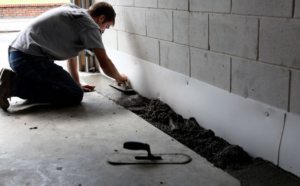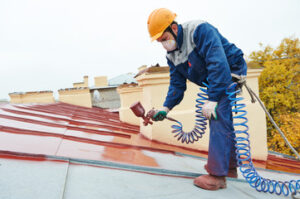Basement Repair Naperville IL is essential for maintaining a healthy home. A waterproof base that prevents moisture infiltration, mold growth, rotting building materials, and other problems.
A few preventative maintenance tips, such as cleaning gutters, grading soil to pull water away from the foundation, and promptly fixing leaks, can eliminate many issues before they become serious. But if signs of damage occur, you’ll need advanced solutions.

The sight of a foundation crack in your basement can cause panic, but it’s important to monitor the problem and take action when necessary. Depending on their size, shape, and location, some cracks indicate a serious structural issue, while others are nothing to worry about. Joshua Parrish, co-owner of Hammer and Handsaw and licensed residential contractor, shares what foundation cracks mean and how you can repair them.
Hairline cracks are common in poured concrete foundation walls and usually don’t pose significant problems as long as they remain at their current width. These cracks are caused by standard settling and shrinkage of the concrete as it cures. They can be fixed with epoxy injection, filling the crack and sealing it from water penetration. A coat of paint that’s formulthat’sor used on masonry, such as INSL-X TuffCrete Acrylic Concrete Paint, will also help.
Other cracks, such as horizontal or diagonal, can be caused by soil movement underneath the foundation or moisture infiltration. If you notice these types of cracks, your best bet is to have the problem addressed by a professional, as they can indicate an active shift in your home’s structure and result in costly repairs.
If the cracks are not severe, it is possible to repair them using polyurethane foam or epoxy injection inside the wall. This type of resolution will stop the cracks from expanding or getting worse and, depending on the extent of the damage, may even close them completely.
Another way to address a minor foundation crack is to install a basement wall support system. This product, which is available from many foundation repair companies, fits against the basement wall and stabilizes it over time to prevent further damage.
When it comes to preventing future foundation cracks, you can do your part by making sure that the area surrounding your home is well-maintained and properly landscaped, with proper drainage away from your house. Cleaning your gutters regularly and ensuring that the downspouts are channeling water at least 10 feet away from the foundation is also a good idea.
Waterproofing
Basements are often damp, and moisture can cause structural problems such as foundation cracks. Waterproofing is a crucial step in basement repair that can prevent future problems. There are several methods of waterproofing a basement, including interior drainage systems, sump pump installation and sealants for cracked walls and floors.
Exterior basement waterproofing involves excavating around the foundation and applying a waterproof membrane. This is a more invasive method than interior waterproofing, but it offers a long-term solution to moisture infiltration. Interior techniques, such as the use of a sump pump and dehumidifiers, are less invasive and more cost-effective than full-scale excavation and basement waterproofing.
To protect against moisture, the first step is to figure out where the moisture is coming from. A simple test will reveal whether the problem is caused by a high water table or groundwater, or simply too much humidity. Tape a square of aluminum foil to the wall and leave it there for 24 hours. If the side of the foil facing into the room has moisture on it, this indicates there is too much humidity. If the other side of the foil is dry, the issue is likely caused by a high water table or groundwater.
For existing cracks, epoxy injection is an excellent option for a long-lasting, durable fix. This technique fills and seals cracks in concrete walls, preventing water seepage. It is especially effective for repairing cracks that are the result of soil settlement or hydrostatic pressure. It is also an ideal choice for repairing bowed basement walls, as it provides a strong and durable reinforcement that can correct the bowing over time.
Before installing a basement sealant, however, it is important to thoroughly clean the area. Many basements have multiple layers of paint, which must be removed before the sealant can bond with bare masonry. It is also necessary to remove efflorescence, the white deposits that form on basement walls in contact with moisture. To protect against moisture, it is also important to install a basement floor drain and ensure that your yard slopes away from the foundation of your home.
Wall Anchors
Wall anchors are used to hang items like picture frames and canvasses, but they can also be a lifesaver when basement walls bow or lean. When these structural problems occur, they can cause serious damage and even safety hazards. Wall anchors are installed to stabilize bowed walls and prevent further movement, but they require professional assessment and installation.
Using wall anchors can help prevent basement leaks and foundation problems, but it is important to use the right type for each situation. Choosing the wrong type can result in a weak hold, or even failure of the anchor itself. If an anchor fails, it should be removed and replaced with a different type or a toggle bolt.
Drywall anchors come in several types, depending on their intended weight limit and the thickness of the wall. Plastic expansion anchors are typically the most economical and best for light loads, while metal hollow-wall drywall anchors (also known as molly bolts) have the highest holding capacity but cost more. They resemble metal versions of a standard drywall screw and have a metal sleeve that expands behind the wall when a screw is driven into it.
These anchors require a predrilled hole, and their pointed end spreads to the sides of the entry hole as it is screwed in. This does not add strength, but it helps the anchor seat tightly in the drywall. The anchor’s winganchor’sre then pulled firmly against the wall to complete its grip.
A newer version of the drywall anchor is called a self-drilling anchor, which does not require a predrilled hole and can be screwed into a wall with just a standard screwdriver. Its wider screw fins help it sit tight in a stud or a hollow wall, but it only has about half the holding capacity of a molly bolt.
If a hollow-wall anchor becomes loose, it can often be removed by prying up the edges of the plastic sleeve with a flathead screwdriver and pulling out the anchor sleeve. This is a fairly simple process, but it can be difficult in older drywall that has been sanded and painted over. If the anchor has failed completely, it should be replaced with a toggle bolt or a stronger type of wall anchor.
Drywall Repair
Drywall is one of the most significant elements that contribute to a basement’s fibasement’such, it requires attention and precision to ensure the seamless unification of each sheet. Moreover, it’s critical thatcriticalit’st drywall be properly taped and mudded to prevent the seams from cracking and becoming mold-prone.
While minor blemishes like nail holes or dents can be touched up and covered with paint to blend seamlessly, bigger issues may call for the replacement of entire panels. When the time comes, you’ll need tyou’llde between a DIY patch kit or full-scale drywall replacement.
A patch kit can address damage to small areas about the size of a doorknob. The kits typically include a self-adhesive mesh patch that sticks to the wall and covers the hole. However, the patch will be slightly raised above the rest of the drywall due to the adhesive. To remedy this, a second coat of compound should be applied, drawing it at least 6 in. beyond the edges of the first coat to feather and blend the repaired area into the remainder of the wall. After both coats have dried, sand the patch lightly to smooth the surface and eliminate any ridges or unevenness.
Before you begin, consult your local building codes to confirm that you’re in comyou’ree with any applicable requirements. Acquiring the proper permit is not only a matter of safety and good practice, but also protects you from legal issues and liabilities that could arise from improper installation or a disregard for regulations.
Whether you choose a conventional drywall or a newer alternative, such as Total Basement Finishing’s EFinishing’sement wall system, be sure to take the time to secure the proper permits to ensure your work complies with your city or state’s rulesstate’sgulations.
The drywall you use in your finished basement needs to stand up to heavy use, frequent exposure to water, and the general dampness of your subterranean retreat. For this reason, the ideal drywall material is moisture-resistant and can withstand repeated flooding without the risk of sagging or molding. It’s also impotentimpIt’snt to install the right thickness for your renovation project. 1/2-inch drywall is standard, but a thicker 5/8-inch option provides superior insulation and soundproofing qualities.



